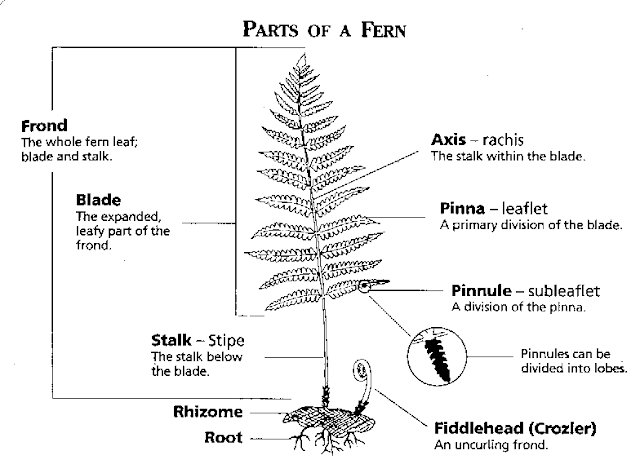Plant of the day is: Oreopteris limbosperma or lemon-scented fern
It has been quite some time since I've hung out with a fern for a good hour, so here goes. I ran across this one today and thought of giant flying Oreo pterodactyl hybrid. Lots of ferns have dinosaur sounding names. It's a thing.
by James Lindsey at Ecology of Commanster
If you SQUINT you can just make out the hairs on the axis and the yellow glands on the pinnules.
Taxonomy/etc.: From the Greek oreos:mountain and pteron:wing in reference to the pinnae. Sometimes called the mountain fern as well. Quick thing about ferns, they have their own special terminology used to describe their morphology. Here is a nice diagram so we can all keep it straight together, because I get confused from time to time as well.
So, the blade is the where the pinnae first start up to the top. The frond is the entire part from the rhizome, and the stipe is the stem or rachis below the blade. There we have it. Ferns don't have leaves, they have pinnae (plural of pinna) that can be subdivided into pinnules.
You can also find this plant listed as Thelypteris limbosperma because of taxonomists doing taxonomy things. The genus comes pretty close to being monotypic but there is also one other species O. elwsii that is included in the genus.
Description: Probably my favorite group of plants to explore the absurd minutia of differences in classification and ID are the ferns. Limbo = marginal and spermum = seed. Marginal seed. In this case of course it means marginal sori (clusters of spores) BUT back in the day (late 1700s) there wasn't as strong of a distinction between seeds/spores. The first picture shows the sori (black dots) on the underside of the pinnae. The individual pinnules aren't quite entirely separate so they can be classified at pinnatifid. Blade is tapering with shorter pinnae towards the top. No visible indusia covering the sori. There are hairs on the axes and VERY small yellow glands. You'd likely have to have a pretty good loop or magnifier to see the glands. See HERE for a great photo of these characteristics. It also has a rather distinguishing erect rhizome which can be seen in the illustration below as the brown ...thing...at the bottom of the stipe.
Most commonly confused with a Dryopteris filix-mas which has pinnae that taper lower to the base, even more marginal sori, and is a bit more slender/less scaly.
Range: Surprisingly tricky on this one. To fully understand it I'd probably have to spend another hour comparing herbarium specimens. Apparently there is some debate on whether or not the North American versions should be classified as Oreopteris. The quick and easy answer is that it is found Europe throughout temperate climates and is certainly a native of the British isles. Whether or not this species is the same that was recently (1976) found in Newfoundland ...remains to be seen.
Etc.: Called the lemon-scented fern because there is a faint lemon smell when you brush the fronds (especially young expanding fronds).
by James Lindsey at Ecology of Commanster
Bonus photo!! ENJOY!





No comments:
Post a Comment